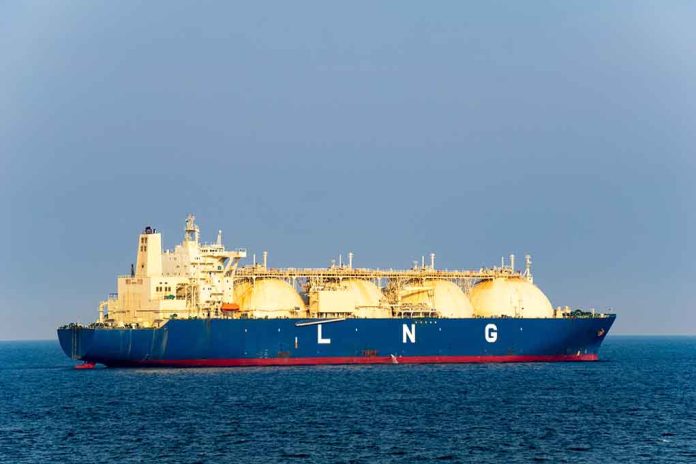🔴 Website 👉 https://u-s-news.com/
Telegram 👉 https://t.me/usnewscom_channel
President Trump’s new shipping fees on Chinese vessels could cost American families thousands while attempting to break China’s stranglehold on maritime trade.
Key Takeaways
- The U.S. Trade Representative will implement fees on Chinese shipping companies and China-made vessels starting October 2025, aimed at countering China’s maritime dominance.
- Fees will be charged up to five times annually per vessel, with steadily increasing rates from 2025 to 2028.
- Critics warn the measures could increase consumer prices, reduce GDP, and diminish U.S. exports by disrupting global supply chains.
- Economists project that over 30 years, these tariffs could reduce GDP growth by 6% and wages by 5%, with middle-income households facing a $22,000 lifetime loss.
- The administration argues these measures are necessary for national security and to revitalize American shipbuilding industries.
America First Maritime Strategy Targets Chinese Shipping Dominance
The Trump administration has unveiled a bold new strategy to reclaim American maritime superiority, announcing fees on Chinese shipping companies and China-made vessels that will begin implementation in October 2025. This move represents a significant shift in America’s approach to trade policy and national security, specifically targeting what officials describe as China’s unfair dominance of global shipping lanes. The fees aim to boost U.S. shipbuilding capacity while improving supply chain security in sectors deemed critical to national interests, part of President Trump’s broader economic nationalism agenda.
“Ships and shipping are vital to American economic security and the free flow of commerce,” said U.S. Trade Representative Jamieson Greer.
According to USTR analysis, China’s strategic investments in maritime infrastructure have systematically displaced foreign firms and reduced competition in global shipping, creating dangerous dependencies and supply chain vulnerabilities for American businesses. The fees will be scaled according to vessel size and type, charged up to five times annually per vessel, with rates increasing progressively from 2025 through 2028. Revenue generated from these fees will be directed toward investments in America’s domestic shipbuilding and maritime industries.
To avoid soaring U.S. tariffs, Chinese manufacturers are racing to set up production facilities in the U.S. Despite higher costs and operational hurdles, companies view local manufacturing as critical to sustaining business.https://t.co/z5bzmgHGSy
Trump’s Trade War Has Already… pic.twitter.com/15NmoGQpnD— Spotlight on China (@spotlightoncn) April 27, 2025
Economic Concerns Mount Over Supply Chain Disruptions
Despite the administration’s national security justifications, industry groups have voiced significant concerns about potential economic fallout. The American Apparel & Footwear Association has warned that these measures could severely impact consumer prices at a time when many American families are already feeling economic pressure. Critics argue that the fees represent an additional tax that will ultimately be passed on to consumers, potentially triggering inflation across various consumer goods categories that depend on maritime shipping for their supply chains.
“These measures are driving up shipping costs, shrinking GDP and reducing U.S. exports,” warned Nate Herman, AAFA’s senior vice president of policy.
Economic analysis from the Wharton School suggests these tariffs could generate up to $5.2 trillion in revenue over the next decade, potentially helping to offset federal debt. However, the same analysis indicates that tariffs may prove twice as damaging to GDP and wage growth as equivalent corporate tax increases. Projections show that over a 30-year period, the tariffs could reduce GDP growth by 6% and wages by 5%, with middle-income households potentially facing a devastating $22,000 lifetime loss in economic opportunity.
Complex Global Supply Chains Present Implementation Challenges
The implementation of these new shipping fees faces substantial practical challenges due to the complexity of modern global supply chains. Many manufactured goods contain components from multiple countries, with assembly occurring across various international locations before reaching American shores. This intricate web of production makes targeting specifically Chinese shipping challenging without causing collateral economic damage to American businesses and consumers reliant on these supply chains.
“The entanglement between economies is so complex,” notes Kent Smetters of Wharton. “Just one of those parts being disrupted could actually lead to you not being able to produce.”
The administration has included several exemptions to mitigate potential disruptions, including routes involving the Great Lakes, the Caribbean, U.S. territories, bulk commodity exports, and vessels arriving without cargo. However, economists remain concerned that these carve-outs may not be sufficient to prevent significant economic ripple effects. The fees will likely increase costs for U.S. businesses dependent on imported components and materials, potentially forcing them to pass these expenses on to consumers or reduce their workforce to maintain profitability.
Long-Term Investment and Debt Concerns
Beyond immediate price increases for consumer goods, economists warn about potential long-term structural impacts on America’s economy. Higher tariffs typically reduce international capital flows and decrease foreign demand for U.S. Treasury bonds, making it more difficult for the federal government to finance its operations at favorable interest rates. As foreign investment decreases, American households may need to absorb more government debt, potentially diverting savings away from productive private investment and into government bonds.
“It will be harder for the government going forward to float its federal debt — that will essentially be at higher prices, but at cheaper interest rates,” explained Kent Smetters.
President Trump’s administration maintains that these short-term economic adjustments are necessary to secure America’s long-term economic independence and national security. By challenging China’s maritime dominance and rebuilding domestic shipping capacity, officials argue the U.S. will become less vulnerable to foreign supply chain disruptions during future crises. The policy represents a clear prioritization of American industrial capacity and national security interests over short-term consumer price advantages – a cornerstone of the President’s America First economic vision.

